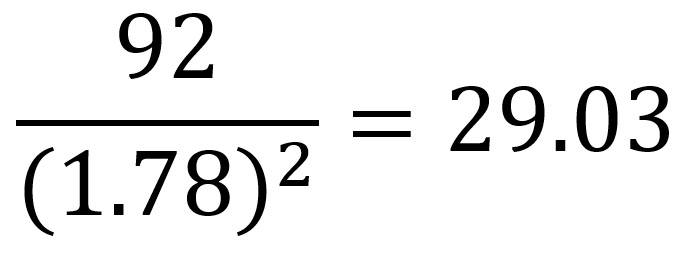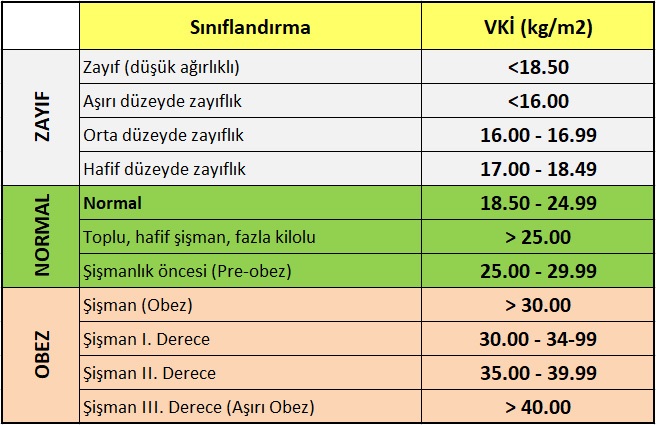
- Obesity disease has increased 3 times since 1975 worldwide.
- Since 2016, deaths due to obesity are more than deaths caused by hunger.
- According to the data of the World Health Organization announced in 2016, 1.9 billion people were detected as fat.
- Obesity disease began to affect children under 5 as well as adults.
- Obesity is one of the chronic diseases that can be prevented and treated.
- Obesity affects not only physical health but also psychological health.
How to Calculate Body Mass Index | Am I Obese?
A standard method has been developed to find out if you’re overweight or how overweight. With this calculation, you get data called body mass index and this data shows you in which range you are.
To calculate your body mass index, all you have to do is just divide your weight by the square of your height.
For example, suppose you are 92 kilograms in weight and 1.78 m tall, so what you need to do is dividing 92 by the square of 1.78:
Then you can see which category you are in according to the following information:
Body Mass Index Calculation Tool
You can use our tool below to easily calculate your BMI value:
[bmi theme=”clean” metric=”Metric” imperial=”Inch” height=”Height” heightPlaceholder=”Height” weight=”Weight” weightPlaceholder=”Weight ” submit=”Calculate BMI” result=”Your BMI: %bmi%”]
The figures announced by the World Health Organization are very important. Health problems caused by obesity and obesity affect the world. Even increasing awareness about obesity cannot produce a definitive solution to this disease. Gastric surgery is an effective bariatric surgery in the treatment of obesity.
Gastric surgery, which has been considered as an important chance for patients with increased obesity to regain their health in recent years, is a bariatric surgery that allows the stomach to be reduced by approximately 80%.
Patients who are unable to lose weight naturally and whose overall health status deteriorates due to their excess weight, after the tube stomach surgery, which allows the restriction of nutritional intake, can completely get rid of their excess weight if they acquire healthy eating and different habits of life.
What is a healthy BMI for surgery?
In order for the operation to be performed, the patient must have a BMI of 35 and above 35. BMI should be more than 35(kg/m2) and at least one obesity-accompanied comorbid condition.
Examples of concomitant comorbid conditions include diseases such as Type 2 diabetes, hypertension, sleep apnea, liver lubrication, Joint Diseases, and cholesterol elevation.
Some experts note that surgery may also be appropriate for patients with a body mass index greater than 30(kg/m2) to reduce the risk of cardiovascular disease and for those with uncontrolled diabetes.
What is Gastric Surgery?
Gastric surgery, also known as Sleeve Gastrectomy, is a surgical operation that allows the restriction of food intake by reducing the stomach volume by approximately 80% permanently.
With the development of technology, small incisions are made in the abdominal region during gastric surgery performed by the laparoscopic method.
Since the volume of the stomach is greatly reduced during the operation, patients feel full enough even after eating a small amount after gastric surgery. They also get rid of the appetite-increasing effect of the hormones leptin and ghrelin secreted in the stomach.
Patients’ appetite levels decrease after Gastric surgery, which has very effective results. If the right nutrition program and a lively lifestyle are implemented, they can get rid of their excess weight.
Patients who lose weight after tube stomach surgery also reduce dangerous health problems such as diabetes, joint disorders, metabolic syndrome, high cholesterol, sleep apnea, and cardiovascular diseases, which can develop due to obesity.
How Is Gastric Surgery Performed?
Gastric surgery can only be performed on or off patients who have the appropriate criteria. In recent years, especially since closed Gastric surgery applications have been made, we will respond to the question “how is Gastric surgery performed?” by explaining the closed method Gastric surgery technique.
After anesthesia, 4 to 5 small incisions are made in the areas of the abdomen within easy reach of the abdominal cavity. In order for surgical instruments to be able to move comfortably in the abdominal region, instruments called trocars are placed in the incisions made.
Carbon dioxide gas is given from the trocars to the operating area, allowing the stomach to separate from other organs. When the stomach is separated from other organs, surgical procedures are performed more safely.
During gastric reduction surgery, surgeons permanently remove the expanding portion of the stomach. When the new stomach is made, the punching method is applied and the punching process is applied to the connecting parts of the stomach to form a tube-like stomach.
After the stapler line is formed with the stapler in the newly formed stomach, the stomach is checked for any leakage and the surgery is completed. During surgery, the stomach valves called “pylorus”, which are responsible for controlling the passage of nutrients into the intestines, are not damaged.
Who Can Have Gastric Surgery?
We often see news from social media and the press about patients having Gastric surgery. Patients, who see the success rate of Gastric surgery and the excellent changes that occur after it, want to have Gastric surgery.
Before answering “Who can have Gastric surgery?” question, we would like to remind you that Gastric surgery is a surgical procedure, that there are some risks involved and that the stomach volume is permanently reduced.
It is very important to determine the preferences of the patients for successful gastric surgery. Gastric surgery is a great opportunity to get rid of excess weight. Patients’ determination and compliance with expert directives determine the operation process.
In order to have gastric surgery, patients must meet the criteria set by the World Health Organization (WHO). Gastric surgery makes it easier for patients to lose weight and physically reduces the volume of the stomach and provides a feeling of fullness even though less food is consumed. In order to have gastric surgery;
- Body mass index value should be minimum 35.
- Patients with a body mass index above 30 but poor general health due to obesity may also undergo stomach reduction surgery.
- Patients whose body mass index values are suitable for surgery and who are also in general health status for surgery may have Gastric surgery.
Who cannot have gastric sleeve surgery?
A person must meet certain criteria to qualify for gastric sleeve surgery. The main goal has been to treat obesity and excess weight. It is performed on patients with a body mass index of 35 and above, determined by the World Health Organization. The average age should be between 8 and 65 years of age Dec.
It is not done to individuals under the age of 18 and over 65 unless necessary or there is no final solution left. Surgery is usually only considered after these other options have been tried.
Weight loss compared to pre-Gastric sleeve surgery can help reduce certain problems such as Type 2 diabetes, asthma attacks, and blood pressure, and can help improve heart health. Although this surgery has a small risk like any surgery, it is usually a safe procedure.
References:
https://www.verywellhealth.com/before-gastric-sleeve-surgery-4164458
https://www.webmd.com/diet/obesity/what-is-gastric-sleeve-weight-loss-surgery






